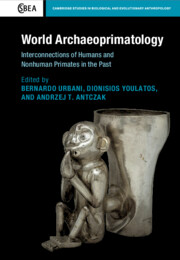24 results
A Primate on a Fresco from the Mycenaean Acropolis of Tiryns
-
- Journal:
- European Journal of Archaeology / Volume 26 / Issue 4 / November 2023
- Published online by Cambridge University Press:
- 10 February 2023, pp. 426-444
- Print publication:
- November 2023
-
- Article
-
- You have access
- Open access
- HTML
- Export citation
Copyright page
-
- Book:
- World Archaeoprimatology
- Published online:
- 03 August 2022
- Print publication:
- 18 August 2022, pp vi-vi
-
- Chapter
- Export citation
10 - Minoan Monkeys
- from Part II - Europe
-
-
- Book:
- World Archaeoprimatology
- Published online:
- 03 August 2022
- Print publication:
- 18 August 2022, pp 225-280
-
- Chapter
- Export citation
Contributors
-
- Book:
- World Archaeoprimatology
- Published online:
- 03 August 2022
- Print publication:
- 18 August 2022, pp xii-xvi
-
- Chapter
- Export citation
Part II - Europe
-
- Book:
- World Archaeoprimatology
- Published online:
- 03 August 2022
- Print publication:
- 18 August 2022, pp 199-280
-
- Chapter
- Export citation
Foreword
-
- Book:
- World Archaeoprimatology
- Published online:
- 03 August 2022
- Print publication:
- 18 August 2022, pp xvii-xix
-
- Chapter
- Export citation
Contents
-
- Book:
- World Archaeoprimatology
- Published online:
- 03 August 2022
- Print publication:
- 18 August 2022, pp ix-xi
-
- Chapter
- Export citation
Index
-
- Book:
- World Archaeoprimatology
- Published online:
- 03 August 2022
- Print publication:
- 18 August 2022, pp 533-538
-
- Chapter
- Export citation
Part I - The Americas
-
- Book:
- World Archaeoprimatology
- Published online:
- 03 August 2022
- Print publication:
- 18 August 2022, pp 11-198
-
- Chapter
- Export citation
World Archaeoprimatology
-
-
- Book:
- World Archaeoprimatology
- Published online:
- 03 August 2022
- Print publication:
- 18 August 2022, pp 1-10
-
- Chapter
- Export citation
Part III - Africa
-
- Book:
- World Archaeoprimatology
- Published online:
- 03 August 2022
- Print publication:
- 18 August 2022, pp 281-416
-
- Chapter
- Export citation
Part IV - Asia
-
- Book:
- World Archaeoprimatology
- Published online:
- 03 August 2022
- Print publication:
- 18 August 2022, pp 417-532
-
- Chapter
- Export citation
Acknowledgments
-
- Book:
- World Archaeoprimatology
- Published online:
- 03 August 2022
- Print publication:
- 18 August 2022, pp xx-xx
-
- Chapter
- Export citation
Dedication
-
- Book:
- World Archaeoprimatology
- Published online:
- 03 August 2022
- Print publication:
- 18 August 2022, pp vii-viii
-
- Chapter
- Export citation
3 - Monkeys on the Islands and Coasts of Paradise
- from Part I - The Americas
-
-
- Book:
- World Archaeoprimatology
- Published online:
- 03 August 2022
- Print publication:
- 18 August 2022, pp 63-107
-
- Chapter
- Export citation
1 - Monkeys in the City of Gods
- from Part I - The Americas
-
-
- Book:
- World Archaeoprimatology
- Published online:
- 03 August 2022
- Print publication:
- 18 August 2022, pp 13-47
-
- Chapter
- Export citation

World Archaeoprimatology
- Interconnections of Humans and Nonhuman Primates in the Past
-
- Published online:
- 03 August 2022
- Print publication:
- 18 August 2022
A new look at the Minoan ‘blue’ monkeys
-
- Article
-
- You have access
- HTML
- Export citation
Chapter 45 - Conservation of Primates and Their Flooded Habitats in the Neotropics
- from Part VII - Conservation, Threats and Status
-
-
- Book:
- Primates in Flooded Habitats
- Published online:
- 24 December 2018
- Print publication:
- 03 January 2019, pp 359-374
-
- Chapter
- Export citation

